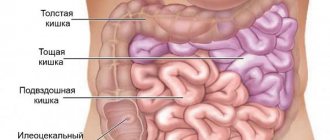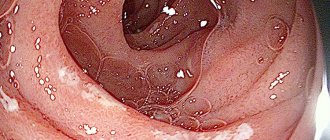Intestinal tuberculosis (syn. tuberculosis of the peritoneum and mesenteric lymph nodes) is a rare but extremely dangerous disease when there is a focus of tuberculosis infection in the intestine. As the pathology progresses, granulomas form, their further melting and the development of fibrosis.
- Etiology
- Classification
- Symptoms
- Diagnostics
- Treatment
- Possible complications
- Prevention and prognosis
It is worth noting that approximately every 2 patients who are diagnosed with tuberculosis die from this type of disease.
The main cause of the disease is the penetration of the microscopic provocateur of tuberculosis infection directly into the intestinal mucosa. There are several ways a pathogenic agent can enter the human body.
The main danger is that the disease can be either completely asymptomatic, or the clinical manifestations are nonspecific and characteristic of other gastrointestinal diseases.
Diagnostics consists of conducting a wide range of laboratory and instrumental examinations. Not least important are the activities performed personally by the gastroenterologist.
Treatment tactics include conservative measures (oral medication and following a gentle diet). Surgery is performed only if complications occur.
Intestinal tuberculosis in humans
Every year, about 3 million people die worldwide due to this severe pathology. From 2000 to 2021, the world is expected to have 1 billion infected, 200 million sick and 35 million dead if control of its spread is not strengthened.
More than a third of the world's population is infected with the tuberculosis bacillus, but the disease does not affect everyone. It most often affects people with weakened immune systems, such as HIV-infected patients and the elderly.
Controlling the spread of infection has always been challenging due to the natural spread of the disease and the wide variety of clinical manifestations in different groups of people.
In the abdominal form of the disease, the gastrointestinal tract is affected. In particular, the pathological process involves the peritoneum, regional lymph nodes and, in rare cases, the kidneys, liver, or pancreas.
Both adults and children get sick equally, with possible complications including intestinal rupture, which in some cases can be fatal for the patient. Gastrointestinal tuberculosis is a major health problem in many underdeveloped countries.
Recently, an increase has also been recorded in developed countries, especially in persons with concomitant HIV infection. Before the invention of new effective drugs, autopsies revealed gastrointestinal involvement in 55-90% of those who died from pulmonary tuberculosis.
Currently, the relationship between the pulmonary and abdominal forms is rarely diagnosed (<50%). In patients with a disease in the digestive organs, X-rays of the lungs usually show no changes.
However, a similar condition can be observed in 20-25% of patients. The tuberculosis bacillus (Koch bacillus) can infect any part of the digestive tract, although most often it forms in the ileum and large intestine.
emedicine.medscape.com
www.epainassist.com
Main symptoms of the disease
Frequent manifestations of the gastrointestinal form include the following symptoms of intestinal tuberculosis:
- fever;
- loss of appetite;
- fatigue;
- weight loss;
- constipation;
- diarrhea;
- stabbing pain in the abdomen;
- painful swelling in the abdominal area;
- night sweats.
Any primary symptom indicates the need for an urgent visit to a doctor. Without waiting for a secondary infection to occur, the specialist will select reasonable drug treatment after the examination.
www.medindia.net
Symptoms of the disease
The main problem is the absence of any specific symptoms at the very beginning of the disease, since there are none, it is very difficult to suspect the presence of pathology. The first signs of the disease may appear a year or 10 years after infection. At the initial stage, the patient notices mild abdominal pain without any particular localization (abdominal pain syndrome). The most characteristic symptom of the disease will be persistent diarrhea, which over time is replaced by constipation. During laboratory tests, specialists may detect tuberculosis bacilli with particles of blood and pus in the stool.
The secondary stage is characterized by severe pain, which has a clear localization, most often manifesting itself in the right iliac region. The patient feels general weakness, high temperature and sudden weight loss. The pain either subsides or appears again.
When the ulcer begins to scar, there is narrowing of the intestines and bloating. As a result, the patient completely loses his appetite. Sometimes a person may additionally feel pain in the navel area, especially during movement. On palpation, a tumor is felt, invisible at first glance.
If you do not seek help from a specialist in time, tuberculosis can cause a number of complications, including:
- Intestinal obstruction (constipation).
- Narrowing of the intestinal lumen (stenosis). This prevents food from passing properly through the intestinal tract, causing it to become stuck, causing pain and other complications.
- Perforation of tuberculous ulcers (formation of a through hole in the wall of the stomach). The contents of the infected area pass into the abdominal cavity.
- Peritonitis (inflammation of the peritoneum, acute abdomen).
- Amyloidosis (deposition of amyloid substance in tissues and organs with subsequent damage to one of them).
- Intestinal bleeding.
The first signs of pathology
The first signs and symptoms of intestinal tuberculosis depend on its form.
Tuberculosis of the abdominal organs manifests itself in 4 main forms:
- Tuberculous lymphadenopathy (changes in the lymph nodes);
- Damage to the peritoneum (peritoneum is the membrane covering the internal organs of the abdominal cavity);
- Gastrointestinal form (damage to the gastrointestinal tract);
- Visceral form (non-hollow internal organs are affected);
Symptoms usually vary greatly from person to person, but the most common symptoms include persistent abdominal pain, weight loss to the point of anorexia, frequent episodes of diarrhea, mild fever and an enlarged abdomen.
www.ncbi.nlm.nih.gov
www.epainassist.com
Treatment methods
The treatment of this disease is carried out by a phthisiatrician together with several specialists (pulmonologist, gastroenterologist and infectious disease specialist).
The first stage of therapy must be carried out in a hospital at an anti-tuberculosis dispensary.
The patient remains on treatment from 2 months to 2 years. The duration of the course primarily depends on the stage of the disease and the size of the affected area. The patient is transferred to home treatment after active bacteria cease to be released from his body into the external environment.
To achieve a therapeutic effect, it is common to combine several treatment methods:
- taking medications;
- physiotherapy;
- diet;
- surgery.
In each case, the course is built according to an individual scheme.
During treatment, it is necessary to follow the correct diet. The patient should eat every 2-3 hours. At first, only pureed foods with a high calorie content are allowed. Recommended dishes include:
- soups;
- porridge;
- homemade pates;
- curd puddings;
- boiled or steamed fish;
- eggs.
A feature of tuberculosis of the abdominal cavity and digestive system is constant thirst. The patient should drink more fluids. These can be fruit drinks, fruit juices, milk, rosehip decoction, compotes.
The disrupted process of food digestion leads to poor absorption of vitamins B and K. To compensate for this deficiency, vitamins are prescribed in the form of injections.
Folk remedies can be used as additional therapy. Decoctions of pine buds, St. John's wort, plantain, anise, and hop cones are suitable for this purpose. To achieve a therapeutic effect, choose one of these plants and prepare a decoction. You need to take the product during meals (2-3 tablespoons). The duration can reach several months.
Medication
As part of treatment, the primary task is to destroy pathogenic bacteria that cause the symptoms that accompany tuberculosis of the stomach and gastrointestinal tract. For this, first- and second-line antimicrobial agents are used. Most often, a TB doctor prescribes at least 2 medications. From a wide list, we can name several of the most popular first-line drugs:
- Rifampicin. This semi-synthetic antibiotic acts on the RNA of the bacteria, thereby blocking its further development.
- Isoniazid. With its help you can stop the proliferation of infectious agents.
- Phtivazid. Under the influence of the active substance, bacterial membranes are destroyed.
- PAS, or sodium aminosalicylate. This medication has bacteriostatic properties (inhibits the growth of bacteria).
In the absence of positive dynamics in the treatment of abdominal tuberculosis, second-line drugs are added. They are characterized by increased power and efficiency.
Ethambutol. Blocks the development of strains resistant to most antibiotics.
Cycloserine. A specialized antimicrobial drug that fights the causative agent of tuberculosis.
Ethionamide. Capable of suppressing protein synthesis in bacteria.
Surgical
Surgery is resorted to only in cases where the patient has ulcerative damage to the intestinal walls, perforation, peritonitis, and internal bleeding.
Diagnosis and treatment of the disease
There is no test that can be called the gold standard for diagnosing intestinal (abdominal) tuberculosis. However, the diagnosis is often made on the basis of radiological and histopathological changes.
A biopsy (examination of a tissue fragment, histologically) can be performed in several ways:
- Endoscopically with insertion of a probe into the gastrointestinal tract;
- Endoscopically using skin puncture with video surveillance;
- Endoscopically under ultrasound control;
- Surgically (laparoscopically), through small holes in the abdominal wall.
A positive result is the detection of caseous necrosis in the area of granulomas on a biopsy. The pathological process is characterized by many granulomas in the mucosa and submucosa, measuring more than 200 microns.
Radiological diagnostic methods include:
- ultrasound examination (ultrasound);
- computed tomography (CT);
- magnetic resonance imaging (MRI);
- X-ray examinations with barium contrast agent.
Initially, ultrasound is always used, as it safely and quickly reveals damage to the lymph nodes, ascites, thickening of the mesentery, omentum and, in some cases, the intestinal wall. X-rays may reveal fecal stones (enteroliths), perforations, and signs of intestinal obstruction. In the diagnosis of strictures, fistulas and erosions, preference is given to methods using barium.
www.ncbi.nlm.nih.gov
Diagnostics
At the initial stage of development, it is extremely difficult to identify this disease, since the symptoms are not typical, and there are no specialized diagnostic methods.
The only 100% accurate way is to examine the discharge for the presence of bacteria. In this case, the difficulty lies in the fact that for the initial isolation and study of the pathogen it takes from 4 to 8 weeks.
Important information: Is tuberculosis of the bronchi and trachea of the upper respiratory tract contagious?
To detect intestinal tuberculosis, a doctor prescribes a diagnosis.
- General blood analysis. Based on the results, the quantitative indicator of the blood formula is taken into account. The diagnosis may be indicated by a high level of eosinophils and leukocytes, and a low content of lymphocytes. ESR is disrupted.
- Coprogram. This term is usually understood as the study of feces to determine its chemical and physical composition. This laboratory test does not always give an accurate result.
- Intradermal tuberculin tests. In some cases, it is not possible to detect the disease in this way.
- Colonoscopy. During this procedure, a rectal colonoscope is inserted into the patient's rectum. All information is transmitted to the monitor screen, thanks to which the doctor receives information about the condition of the intestinal walls. During the examination, ulcers, narrowing of the lumen, and neoplasms are discovered.
- X-ray (standard and with contrast agent). It can be used to identify ulcers, calcified lymph nodes, and changes in the structure of the mucosa.
- X-rays of light. Used to identify the primary source of infection.
- Ultrasound and computed tomography help determine the location of the pathology. Thanks to this, it is possible to identify tuberculosis of the peritoneum and other organs adjacent to the intestines.
- Biopsy. Such laboratory testing is required only in certain cases.
Complications and possible consequences
What are the possible complications of intestinal tuberculosis? Koch's tuberculosis bacillus in the abdominal cavity, left without treatment, can lead to the development of intestinal obstruction, fistulas, abscesses, perforations with bleeding, and, as a consequence, peritonitis.
A fistula is an uncharacteristic joint between two parts of the body that should not normally be connected. Fistulas can form between an organ and a blood vessel or any other structure, often occurring at the site of inflammation or infection.
Peritonitis is a severe inflammatory disease of the serous membranes, through which the internal organs are attached to the abdominal wall. The disease often provokes various complications.
The mesentery (an organ of the human digestive system through which the hollow organs of the abdominal cavity are attached to the posterior wall of the abdomen.) reacts first and sharply to any pathogenic stimulus. An acute inflammatory reaction develops, which without timely treatment can be fatal.
www.pediatriconcall.com
www.medlineplus.gov
emedicine.medscape.com
Causes of the disease
An irritating factor in the development of intestinal tuberculosis is the direct transfer of bacteria into the intestinal mucosa from the lungs. Most often this occurs during secondary infection. Primary occurs extremely rarely, since the stomach is highly resistant to such infection.
And now about how tuberculosis is transmitted in detail:
- by airborne droplets;
- nutritional;
- contact
Airborne infection occurs when an infectious agent enters the body of a healthy person when a patient coughs, talks, or sneezes. The mycobacteria it secretes penetrate the lungs and remain viable there for some time (up to 18 days). Tuberculosis becomes dangerous when it is open because an infected person produces and spreads mycobacteria.
Healthy family members and colleagues of the patient are at risk. You can become infected by drinking unboiled milk from a cow that was a carrier of the microbe. Animals quite often carry Koch's bacillus, but, unlike people, the infection does not cause them any harm. Tuberculosis is contagious.
Alimentary (deglutation) method: bacteria enter the body through the digestive tract. This is how esophageal tuberculosis occurs during secondary infection. A patient with this diagnosis, coughing, swallows his own bacillary (infected) sputum, which ends up in the stomach. However, it is worth noting that even with this process, the transmitted bacteria are activated only under certain conditions. For example, if a person has low immunity, various inflammations and other pathologies, diseases of the gastrointestinal tract. But the contact route is a rather rare case in medical practice. Infection is transmitted through the eyes or damaged skin.
Intestinal disease affects the lymph nodes of the mesentery (the organ in the digestive system through which the empty sectors of the abdominal cavity are attached to the back wall of the abdomen). New growths in the form of tumors or many red nodules (granulomas) appear in the affected areas. They fester and soon burst, forming bleeding ulcers.
Gastric tuberculosis can be divided into several subtypes:
- ulcerative-hypertrophic;
- hypertrophic;
- inflammatory;
- miliary (with miliary tuberculosis).
Peritoneal tuberculosis has 2 forms: adhesive and exudative.
Infection of the small intestine
Clinical symptoms of small intestinal tuberculosis include abdominal pain, anemia and fever with profuse sweating at night. Patients may be diagnosed with intestinal obstruction, pain in the right iliac region and palpable swelling there.
Bleeding and perforation are considered to be complications of the disease.
Malabsorption can be caused by intestinal obstruction, which in turn leads to the growth and proliferation of bacteria in the small intestine, a condition known as blind loop syndrome. Mesadenitis, or tuberculosis of the mesenteric lymph nodes, can also lead to disruption of the processes of digestion and absorption in the intestines.
The ileum is affected more often than the jejunum. Involvement of the ileocecal angle is observed in 80-90% of cases. This is explained by the abundance of lymphoid tissue (Peyer's patches) in this area.
Mild disease of the small intestine with overlying involvement is usually characteristic of M. avium infection. Obstruction can be partial (stenotic) or complete.
emedicine.medscape.com
Intestinal tuberculosis
Intestinal tuberculosis is an infiltrative and ulcerative lesion of the intestine by mycobacterium tuberculosis, mainly the cecum and ileum, from which the process spreads to the peritoneal lymph nodes. It can occur as primary tuberculosis, or secondary to tuberculosis of the lungs or genital organs. Etiology and pathogenesis
Intestinal tuberculosis can be either a primary or secondary disease. The immediate cause of the development of the disease is the introduction of Mycobacterium tuberculosis into the intestinal mucosa. Primary intestinal tuberculosis practically does not occur.
Ways of occurrence of secondary intestinal tuberculosis: deglutation, lymphogenous and hematogenous. If previously it was believed that intestinal tuberculosis occurs in seriously ill patients with pulmonary tuberculosis as a result of the systematic ingestion of bacillary sputum and intestinal tuberculosis was considered as the final chord of the general tuberculosis disease, now, although the deglutative method of occurrence is not denied, there are more and more supporters of the lymphohematogenous path of development of tuberculosis And the intestines.
Confirmation of this development path is the finding of ulcerative intestinal tuberculosis in patients with limited focal pulmonary lesions without decay or in patients with extrapulmonary localizations of tuberculosis (osseous-articular, genitourinary system and other internal organs). Most often, intestinal tuberculosis occurs as a secondary process that begins to develop with progressive pulmonary tuberculosis. The stomach is characterized by a high level of resistance to tuberculosis infections. Accordingly, even with regular ingestion of virulent bacteria in large quantities (in the case of pulmonary tuberculosis), complications such as secondary damage to the intestines and stomach do not occur in all cases. As a rule, intestinal tuberculosis is primarily manifested by inflammation of the lymph nodes, namely the development of tuberculous mesadenitis. The affected areas of the intestine are subject to the appearance of specific infiltrative-ulcerative tumor-like formations, and the appearance of multiple dense small nodules known as granulomas is also possible.
Symptoms and course:
Intestinal dysfunction, often diarrhea, loss of appetite, pain, sometimes acute, usually in the right iliac region and around the navel, against the background of a fever and progressive emaciation. The abdomen is swollen, and a compacted cecum can be felt.
Recognition:
Along with the clinical picture, the presence of Mycobacterium tuberculosis in the stool and characteristic radiological symptoms, positive tuberculin tests.
Extrapulmonary forms of tuberculosis (general characteristics)
Tuberculosis affects almost any organ. According to localization they distinguish:
- osteoarticular (occurs in 47% of all patients with extrapulmonary tuberculosis);
- genitourinary organs (37%);
- eye (5.5%);
- meninges (meningitis - 4%);
- lymph nodes (2.5%);
- peritoneum (1.5%);
- skin;
- Tuberculosis of other organs is very rare: pericardium, adrenal glands, intestines, etc.
Extrapulmonary forms of tuberculosis are more common in adults (79%) and less common in children and adolescents (16% and 5%, respectively).
Regardless of the location of the lesion, the cycle of inflammation is the same everywhere: the focus (granuloma) - its melting (caseosis) - the formation of a decay cavity (cavern) - the appearance of fibrosis during sanitation (sclerosing). The initial manifestations of the disease with minimal lesions give a picture of intoxication of the body. As the process spreads, its symptoms depend on the disorders inherent in the affected organ. Recognition of extrapulmonary tuberculosis is impossible without X-ray examination and tuberculosis tests.
Diagnosis is carried out taking into account three stages of disease development:
the first stage is the appearance of a primary focus of tuberculous inflammation within the smallest anatomical unit, gradually spreading by contact;
the second stage is the involvement in the pathological (painful) process of surrounding tissues and organs that are functionally closely related to the affected organ (for example, the spread of tuberculosis to the urinary tract with kidney tuberculosis, etc.);
the third stage is complete destruction of the organ, system and surrounding tissues by tuberculosis with the occurrence of complications.
Treatment
Mild forms of intestinal tuberculosis are (relatively) treatable with tuberculostatic drugs. It is worth noting that complete cure is not achieved in all cases. Today, the most effective treatment for tuberculosis infection is a modern combined method, which includes the use of two drugs at once. Mycobacteria multiply for quite a long time and tend to stay in the patient’s body for a long time, so chemotherapy courses take a long time.
All medical procedures aimed at treating various forms of tuberculosis are usually carried out in hospitals specially designed for this purpose. The combination treatment includes taking drugs such as rifampicin and isoniazid. Basically, this course lasts 9 months. Most often, this treatment method achieves good results. In order for anti-tuberculosis treatment programs to lead to the desired result, it is necessary to carefully follow all the recommendations of the attending physician.
Is intestinal tuberculosis contagious or not?
Extrapulmonary forms of the disease usually do not pose a risk to others, with the following exceptions:
- the presence of concomitant pulmonary pathology;
- disease in the mouth or larynx;
- extrapulmonary form of the disease with open drainage.
Some people, even with open pulmonary infection, are no longer infectious within two weeks of starting treatment, but some researchers say it can sometimes take months until a person completely stops releasing bacteria into the environment.
Tuberculosis bacteria are very persistent in the environment.
A decrease or complete disappearance of symptoms usually indicates that a person is not contagious, but this is not always true - only a qualified doctor can determine whether a person is contagious or not.
www.sntc.medicine.ufl.edu
www.medicinenet.com
Reasons for the problem
There are certain causes of abdominal tuberculosis that are directly related to the routes of infection:
- First, the tubercle bacilli can enter the gastrointestinal tract through contaminated milk or saliva. The first to be affected is the intestinal mucosa with the formation of epithelioid tubercles in the lymphoid tissue of the submucosa. After 2-4 weeks, caseous necrosis of the tubercles leads to ulceration of the overlying mucosal tissue. Subsequently, the infection can spread to deeper layers, lymph nodes and mesentery. Less commonly, rods can penetrate the portal bloodstream or hepatic artery, involving the liver, pancreas and spleen in the pathological process.
- The second pathway involves the transport of microorganisms from another site somewhere in the body to the internal parenchymal organs, kidneys, lymph nodes and mesentery.
- Thirdly, the infection can spread by contact from nearby foci: fallopian tubes, appendages and abscess of the lumbar muscle (with tuberculous spondylitis).
- The latter route involves lymphatic vessels through which the rods migrate from infected nodes.
www.ncbi.nlm.nih.gov
Diagnosis of the disease
If a person has intestinal tuberculosis, diagnosis begins with an examination of the abdominal organs. The image will clearly show pathological processes that cannot be confused with another disease:
- scarring;
- manifestations on the colon mucosa (esophagitis);
- sometimes the organ can become filled with feces.
Another way to check is the Mantoux test reaction. If after the injection 48 minutes later a papule larger than 10 mm forms on the skin, most likely this will indicate the presence of a tuberculosis bacillus in the body. Ultrasound examination (ultrasound) will detect damage to certain parts of the intestine, enlarged lymph nodes and ascites (fluid in the abdominal cavity). Using a coprogram (stool is taken for examination), it is only possible to establish the subtype of digestive disorders, but not to make an accurate diagnosis.
The blood test will reveal:
- Leukocytosis with neutrophilic shift (the blood is checked for leukocytes, and then their percentage is displayed in a special graph - leukogram). By shifting to the right or left, it is possible to draw conclusions about the presence of a certain disease in a person.
- Eosinophilia (increased number of eosinophils in the blood). This is one of the subtypes of leukocytes.
- Lymphopenia (low concentration of leukocytes in the blood).
- Acceleration of ESR (erythrocyte sedimentation rate).
- Dysproteinemia is a violation of the normal ratio of blood protein fractions.
Effective treatment of the disease
The disease is well treated with medication, so early diagnosis can prevent unnecessary surgery. Since it is extremely difficult to recognize the pathology on your own, at the first symptom you should consult a doctor.
All confirmed cases must be treated for a minimum of 6 months. For the first 2 months, patients take isoniazid, rifampicin, pyrazinamide and ethambutol three times a week. However, many doctors prefer to extend the course to 9-12 months.
If we talk about surgical methods of treatment, then three types of operations are possible:
- Creation of a shunt between the two ends of the intestine, allowing you to bypass the affected area (enteroenteroanastomosis, or ileotransversal colostomy)
- Radical resection (right hemicolectomy), which, when combined with drug treatment, can completely eradicate the disease. However, we should not forget that this type of operation is often complicated by the appearance of malnutrition (malnutrition) in patients, and therefore is not preferable. This is the rarest operation.
- Conservative operations, such as stricturoplasty (expansion of the stricture) in cases where the narrowing is more than 50% of the lumen. Today, surgeons prefer this type of surgery.
If perforations occur, resection of the affected area is usually prescribed, followed by primary anastomosis. If the disease is chronic, constant monitoring by a specialist is necessary.
www.ncbi.nlm.nih.gov
Treatment
At the present stage, treatment of tuberculosis is quite effective. Typically, treatment of intestinal tuberculosis is carried out inpatiently in specialized dispensaries. First of all, the patient is prescribed drugs for tuberculosis. If they are not effective enough, chemotherapy is given.
If the disease is detected at a late stage or it does not respond to conservative treatment, surgery may be performed.
Timely consultation with a doctor and compliance with all his recommendations is extremely important. Intestinal tuberculosis is a dangerous disease that threatens a large number of complications.











